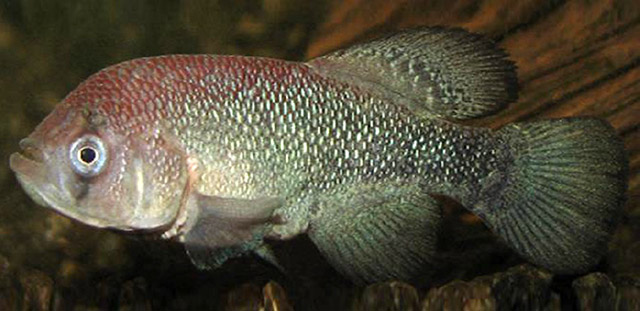|
Dorsal spines (total): 0-0; Dorsal soft rays (total): 18-20; Anal spines: 0-0; Anal soft rays: 19-22. Diagnosis: Nothobranchius bojiensis differs from the other species of the genus, with the exception of N. fasciatus, by its strongly curved dorsal profile with almost no transition to the head (Ref. 26692). It differs from the related N. microlepis by its curved vs. concave dorsal-head transition, greater interorbital width, 12.0-16.4% of standard length vs. 9.4-15.4%, shorter snout, 4.8-7.3% of standard length vs. 6.3-9.1%, higher number of rays in dorsal and anal fins and higher number of scales on the longitudinal series (Ref. 26692). It differs from the related N. fasciatus by its red brown vs. blue grey body and fin colour in preserved males, a greater body depth in males, 28.1-37.6% of standard length vs. 27.7-31.9%, higher number of rays in dorsal and anal fins and higher number of scales on the longitudinal series; the scales are smaller and more irregularly set (Ref. 26692).
Description: Body scales small and irregularly set, those of the mid-lateral series with a shallow pit; frontal part of the head scaleless; operculum, preoperculum and cheek with numerous very small scales (Ref. 26692). Mouth wide, directed upward, maxilla extending to level just in front of anterior rim of pupil; numerous conical teeth in upper and lower jaw, those of the outer row somewhat enlarged; teeth embedded in sponge-like tissue; branchiostegal membrane projecting beyond operculum; gill rakers of first arch 25-30 (Ref. 26692). Neuromast systems as in Nothobranchius microlepis and N. fasciatus (Ref. 26692). Male: robust and, relatively to other Nothobranchius, large fish; body deep, 2.7-3.6 times in standard length; head large, 3.2-3.7 times in standard length; dorsal and anal rounded, tip of rays slightly projecting from the membrane; papillae present on posterior dorsal rays and all anal rays; proximal half of these fins covered with epidermal tissue, papillae slightly projecting; caudal slightly truncate; free end of branchiostegal membrane wrinckled; ctenii present on scales near base of pectoral, lower part of operculum and just above anal (Ref. 26692). Female: smaller than males of same age; body depth 3.9-4.4 times in standard length, head large 3.6-3.7 times in standard length; dorsal rounded, anal pointed, rays 4-12 long and rigid, branched near tip; caudal slightly truncate; neither ctenii on scales nor papillae on fin rays; free end of branchiostegal membrane not wrinckled (Ref. 26692).
Colouration: Male, preserved in alcohol: body pale red-brown, lighter on the lower part of body and head; on the posterior part of body, especially behind pelvic fins, irregular, thin vertical darker reddish brown bars; in some specimens these bars are less distinct than in others; dorsal reddish brown, lighter at the base, becoming darker distally; at the base a pattern of darker red-brown spots; anal red-brown, pale at its base and grading to a dark red-brown distally, no visible markings present; caudal uniformly red-brown, lighter than distal parts of dorsal and anal; pelvic dark red-brown, darker towards the tip; branchiostegal membrane pale brownish (Ref. 26692). Female, preserved in alcohol: body light yellowish brown; some short red brown vertical bars may be present on the posterior body part; all fins pale whitish, somewhat transparent (Ref. 26692). |
